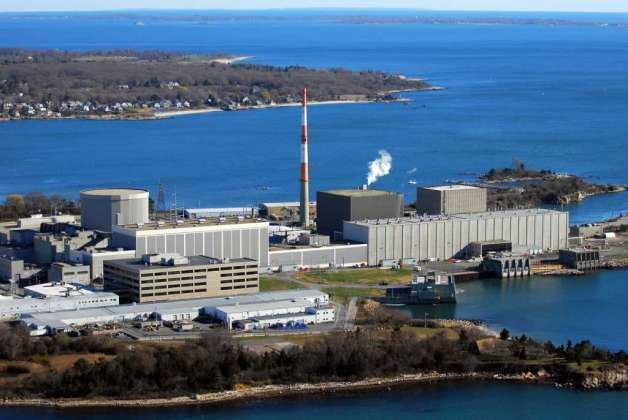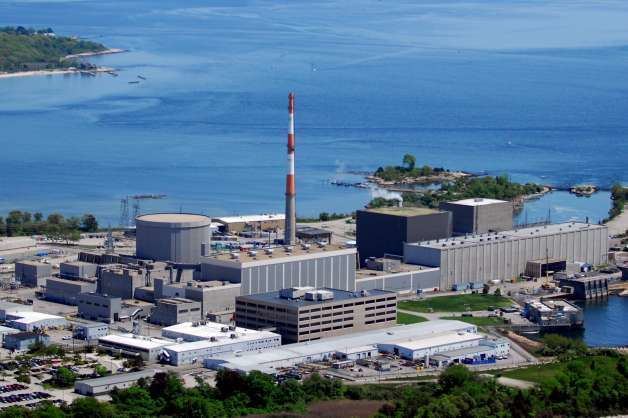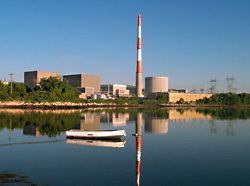Country United States Status Operational | Reactor type PWR | |
 | ||
Commission date Unit 2: December 26, 1975Unit 3: April 23, 1986 Construction cost Unit 2: $424 millionUnit 3: $3.77 billion | ||
Millstone nuclear power plant siren pictures
The Millstone Nuclear Power Station is the only nuclear power generation site in Connecticut and the only multi unit nuclear plant in New England. It is located at a former quarry (from which it takes its name) in Waterford.
Contents
- Millstone nuclear power plant siren pictures
- BackgroundEdit
- Unit 1Edit
- Unit 2Edit
- Unit 3Edit
- 1971Edit
- 1972Edit
- 1977Edit
- 1978Edit
- 1990Edit
- 1995Edit
- 1996Edit
- 2002Edit
- 2005Edit
- 2009Edit
- 2016Edit
- Surrounding populationEdit
- Seismic riskEdit
- References

Following a Time magazine cover story on safety issues at Millstone, all three units were shut down. Units two and three were restarted and are still operating at a combined output rating of 2020 electrical megawatts, or MWe; unit one did not restart, permanently ceasing operations in July 1998.

BackgroundEdit

The Millstone site covers about 500 acres (2 km²). The power generation complex was built by a consortium of utilities, using Niantic Bay (which is connected to Long Island Sound and the Atlantic Ocean) as a source of coolant water.

Since opening in the 1970s, the plant has had numerous safety-related shutdowns and at times been placed on enhanced examination status by the Nuclear Regulatory Commission.
In 1999 Northeast Utilities, the plant's operator at the time, agreed to pay $10 million USD in fines for 25 counts of lying to federal investigators and for having falsified environmental reports. Its subsidiary, Northeast Nuclear Energy Company, paid an additional $5 million for having made 19 false statements to federal regulators regarding the promotion of unqualified plant operators between 1992 and 1996.

Millstone Units 2 and 3, both pressurized water reactors (one from Westinghouse and one from Combustion Engineering), were sold to Dominon Resources by Northeast Utilities in 2000 and continue to operate.
On November 28, 2005, after a 22-month application and evaluation process, Millstone was granted a 20-year license extension for both units 2 and 3 by the NRC.
Unit 1Edit
Millstone 1 was a General Electric boiling water reactor, producing 660 MWe, shut down in November 1995 before being permanently closed in July 1998.
Unit 2Edit
Millstone 2 is a combustion engineering plant built in the 1970s, and has a maximum power output of 2700 thermal megawatts, or MWth (870 MWe). It has 2 steam generators, and 4 reactor cooling pumps. It is undergoing an upgrade to its safe shutdown system which already met NRC standards. During its refueling outage in October 2006, the operator installed a new pressurizer.
Unit 3Edit
Millstone 3 is a Westinghouse plant that started operating in 1986, and has a maximum power output of 3411 MWth (1150 MWe). In the summer of 2008, the NRC approved a power uprate for Unit 3 that increased its electrical output 7.006% to 3650 MWth (1230 MWe). The increase took effect by the end of 2008.
1971Edit
In the summer of 1971, more than 2 million menhaden fish were killed on the intake screens of the plant's cooling system.
1972Edit
In April 1972, 20-30,000 menhaden fish died when they were trapped in an intake lagoon that formed part of the cooling system.
Over five days in 1972, the plant's primary cooling system killed an estimated 150 million Atlantic fingerling menhaden.
1977Edit
In December 1977, two hydrogen explosions occurred at the plant. The second explosion injured one man, who required hospitalization.
1978Edit
Between May and July 1978, the containment dome of Millstone unit 2 was periodically purged of its atmosphere in order to reduce radioactivity levels inside the dome.
1990Edit
In October 1990, operator error during a routine test caused a shutdown of unit 2. In September 1991, twenty reactor operators failed required licensing examinations. The shortfall of licensed operators necessitated a shutdown of unit 1 until March 1992.
1995Edit
The U.S. Nuclear Regulatory Commission began a safety investigation relating to refueling procedures at Millstone unit 1, based on information provided by George Galatis, a senior nuclear engineer, in 1995.
1996Edit
On February 26, 1996, a leaking valve forced the shutdown of units 1 and 2. Multiple equipment failures were found. Time magazine featured the plant on its cover, calling its operator a "rogue utility", and the Nuclear Regulatory Commission singled out millstone for additional attention.
Also in 1996, the plant released one gallon per hour of hydrazine into Long Island Sound. The plant's operators were convicted in 1999 for falsifying environmental records related to the hydrazine release.
Following the Time article and the subsequent shutdown of all reactors, unit 2 restarted May 11, 1999 and unit 3 restarted July 1, 1998. Unit 1 was never restarted as the cost of remedying numerous safety issues was too high.
2002Edit
In 2002 Millstone's operators were fined $288,000 USD for failing to have properly accounted for two uranium fuel rod components that had been misplaced 30 years earlier in 1972.
2005Edit
On April 17, 2005, Millstone unit 3 safely shut down without incident when a circuit board monitoring a steam pressure line short-circuited, which caused the board to malfunction and indicate an unsafe drop in pressure in the reactor's steam system, when in reality there was no drop in steam pressure. The cause was attributed to tin whiskers on the board. In response to this event, Millstone implemented a procedure to inspect for these whiskers at every refueling outage, or 18 months.
2009Edit
In September, 2009, unit 2 shut down when an electrical storm caused power fluctuations. When workers tried to restart the unit, they discovered a small leak in the reactor coolant pump.
On December 21, 2009 the Unit 3 reactor tripped and shut down for longer than 72 hours.
On July 27, 2009, the Unit 2 reactor tripped and shut down for longer than 72 hours.
On August 9, 2013, the Unit 3 reactor trip and shut down due to a malfunction.
2016Edit
In 2016, unit 3 was shutdown following a hydrogen gas leak.
Surrounding populationEdit
The Nuclear Regulatory Commission defines two emergency planning zones around nuclear power plants: a plume exposure pathway zone with a radius of 10 miles (16 km), concerned primarily with exposure to, and inhalation of, airborne radioactive contamination, and an ingestion pathway zone of about 50 miles (80 km), concerned primarily with ingestion of food and liquid contaminated by radioactivity.
The 2010 U.S. population within 10 miles (16 km) of Millstone was 123,482, an increase of 29.5 percent in a decade, according to an analysis of U.S. Census data for msnbc.com. The 2010 U.S. population within 50 miles (80 km) was 2,996,756, an increase of 9.5 percent since 2000. Cities within 50 miles include Hartford (41 miles to city center).
Seismic riskEdit
The Nuclear Regulatory Commission's estimate of the risk each year of an earthquake intense enough to cause core damage to the reactor at Millstone was Reactor 2: 1 in 90,909; Reactor 3: 1 in 66,667, according to an NRC study published in August 2010.
